“I look at Domenico, who is not on any social networks, and he’s calmer than I am,” said Stefano Gabbana as we stood in the middle of Alta Moda Atelier on Friday, waves of pink and daffodil yellow silk tulle lapping at our feet, twinkly chandeliers overhead. (This is not your average work space. It is not your average fashion house, being still largely owned by its designers. They do things differently here.)
We were discussing the industry’s current one-solution-fits-all approach which places speed – of communication, if not always of delivery – at the heart of all its business briefings. “But that isn’t right for everything,” says Gabbana.
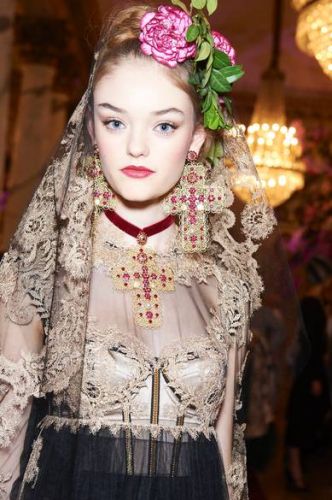
“Alta Moda (Italian haute couture) and ready-to-wear are completely different stories,” adds Domenico Dolce. “With ready-to-wear it’s about what’s hot now, what’s cool, what message are you trying to get across? You’re always aware that at the end of the day you have to sell a lot of clothes to millions of women.” (And by extension, perfume and accessories to tens of millions.)
With Alta Moda it’s almost the opposite. “You have a direct line to your clients. You know who they are. You’ve built up relationships with them. You don’t have to sell a lot. You just have to keep the client happy, not with messages or trends, but clothes they can wear for every aspect of their lives.”
In the four years since Dolce and Gabbana launched Alta Moda, they have become well acquainted with their clients. These days they approach a collection with a fuller understanding of what an Alta Moda client’s life is like, the clothes she requires. “And they’re not the big showy gowns,” says Dolce. “What sells fastest is daywear. It’s not just about special big events. These women – they want to live in Alta Moda.”
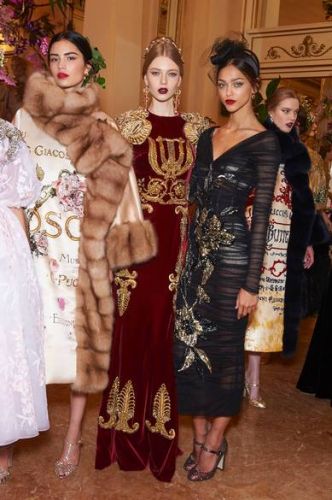
The venture has far exceeded even Dolce’s dreams. He was the one who agitated to do Alta Moda in the first place. Gabbana was far more cautious, sceptical even. Eight seasons on, the number of clients attending the show has doubled. There were 200 at this one. Others who prefer not to be there in person will place orders later. The atelier, constantly expanding, now employs 100 full time seamstresses. That the rest of the fashion industry, now at a disjuncture of season-logjam, jittery stock markets and faltering demand, should enjoy such success.
Perhaps most notably of all, in marked contrast with the ever proliferating roll call of disenchanted (and former) creative directors at other houses, both designers remain palpably enthused if not delighted by their jobs. And why not? As owner designers they are masters of their fate.
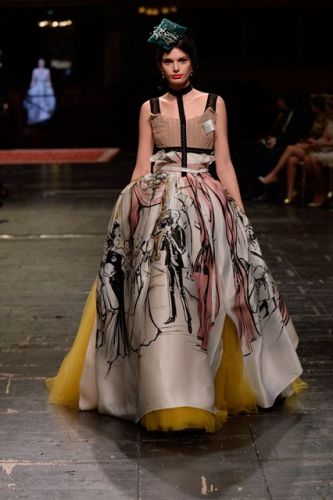
How to share this story without over-sharing? There are probably now more than 20 journalists from around the world who come to the show, but no bloggers. These are reverse ratios at most couture shows. But, as Gabbana says, it’s first and foremost about the clients. Dolce and Gabbana have come to know so well what some of their customers want – one or two order as many as 12 outfits a season – they can design with them specifically in mind. With that level of personal relationship, “digital bombardment,” as Gabbana says, “isn’t appropriate.”
It’s certainly true that the short attention span of those swiping through their Instagram feeds seems instinctively incompatible with the painstaking concentration of the white-coated, black-lace collared seamstresses bent over their embroidery and silks. Yet Instagram also provides the public with hitherto unparalleled access to close-ups of that workmanship. Often it’s close-ups – of the spring/summer 2016 cross-stich floral dress that took six months to complete, for instance – that garner most likes. Depending on your followers these intimate glimpses of a hitherto closed world are more appreciated than yet another paparazzi-style shot of the Kardashians.
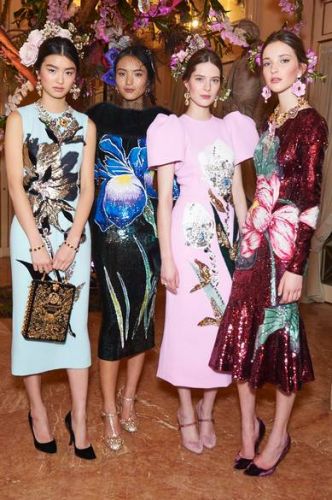
Not that there are any Kardashians at an Alta Moda show. These dresses won’t be seen on any red carpet. Dolce & Gabbana value exclusivity. The impact lies not with a celebrity front row, but with the clothes themselves, and the innately Italian setting. This time it was the stage itself of La Scala, the first time any fashion label has been invited to take its place there.
Opera is to Italians what Shakespeare is to the British, but more accessible. “It’s like the Pope and the catholic church,” explained Dolce. He didn’t just mean the latter’s fondness for lavish clothes.
That helped though. The clothes in this new collection are of course, spectacular. The “simple” (in its fit-and-flare shape) cross stitch dress. The floor-length velvet cloaks (take-out trend from couture? It’s all about the cloak) and gowns with (real) gold embroidered pillars, so thick as to become 3-D. The jewelled cloque opera coats. The pink, bright yellow and emerald green ball-gowns with layers of white silk, illustrated with operatic scenes or images of Biki, a famous-in-Milan couturier between 1940 and 1960 who dressed many of Italy’s best dressed socialites…
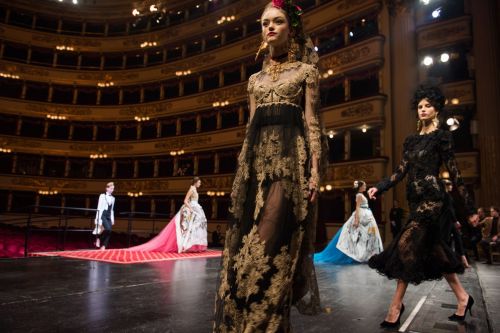
But while Turandot vignettes were lovingly depicted in gold thread and beading across trains and bodices, it is the understated clothes that stay in your mind. A series of black, fitted wool calf-length dresses each had different seaming to contour different bodies and sleeves, some short, some almost knee-length. Ballerina-skinny, punctuated with columns of gold buttons, these are the kind of slender, second-skin sleeves one only finds in Alta Moda or couture.
Gradually black gave way to blush pink, baby blue, with single large blooms traced in velvet, satin and crystal appliqué. Three-piece trouser suits and tweed skirt suits were so deliciously fitted and timeless you could easily find yourself justifying spending the equivalent of a mid-price BMW on one. Or at least those are the sums I found myself doing.
Clients on the whole don’t participate in this kind of arithmetical hoop jumping. The wealth on display is astonishing. There are tiaras and crowns (and that’s just on the men) diamonds and trains – at 11 in the morning. “We learned quite early on that while we can do jewelled necklines for ready-to-wear, Alta Moda clients want to be able to show their own jewellery,” Gabbana told me. “So we keep things more plain, and design necklines where you can do the necklaces.”
The unbridled extravagance of their clients is another reason Dolce and Gabbana are sensitive about the social media presence. They are not immune to the world outside, even if some of their beyond-wealthy clients are. This, as much as an aura of discretion, is why initially the designers banned all social media from Alta Moda.
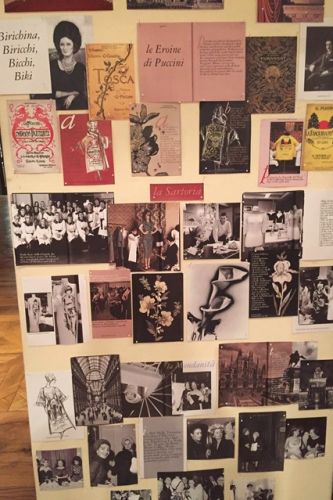
And yet, and yet… increasingly pictures from the Alta Moda shows appear on Instagram and even Snapchat. Who can resist wanting to share a blush pink velvet Alta Moda shoe with a pagoda inspired curved heel, or the netted, rose strewn head-wear, or a black lace evening dress with huge, cloud like sleeves, or a jewelled empire line gown that out-dazzles anything in the current BBC adaptation of War & Peace.
Despite requests to journalists not to put pictures on social media, Gabbana is often among the first to post pictures from the Alta Moda show on his feed.”Aaah,” he shrugs, “I only re-gram pictures the clients have posted. If they put it out there then I feel I can. Some want to share it with the world, others don’t.” The beauty of Alta Moda is you can do both.

